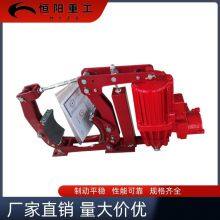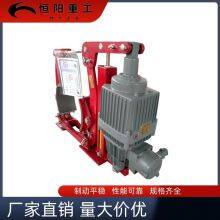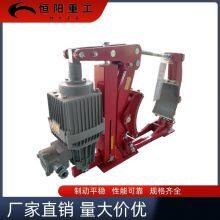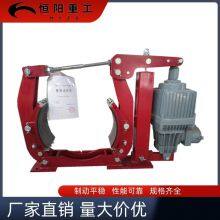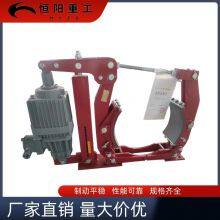YWZ5-250/30 Dust and Gas Industrial Explosion-proof Brake for Coal Mine and Chemical Plant
Structure and working principle
The brake consists of yoke, excitation coil, spring, brake disc, armature, spline sleeve, mounting dowel, etc. The brake is mounted at the rear end of the flange (or motor) of the equipment; the drive shaft and the spline sleeve are coupled with the brake disc.
Brake excitation coil connected to the rated voltage (DC), the electromagnetic force suction armature, so that the armature and brake disc disengagement (release), then the drive shaft with the brake disc normal operation or start, when the transmission system separation or power failure, the brake is also at the same time power failure, this time the spring pressure on the armature, forcing the brake disc and the friction torque between the armature and flange to produce a rapid stopping the drive shaft. In the brake heat dissipation environment is poor, the drive shaft is a long time continuous work, if the conditions allow, then the brake can be kept after the work of the voltage conversion to 70% -80% of the rated voltage, in order to reduce the heat .
A mechanical part that stops or slows down the moving parts in a machine. Commonly known as brake, brake. Chain Dai electromagnetic brake is mainly composed of brake frame, brake parts and manipulation device. Some electromagnetic brakes are also equipped with automatic adjustment devices for the clearance of braking parts.
The resisting torque that must be applied to stop or decelerate the mechanical running parts is called braking torque. Braking torque is the basis for designing and selecting brakes, and its size is determined by the type of machinery and working requirements. The performance of the friction material (brake) used on the brake directly affects the braking process, and the main factors affecting its performance are the operating temperature and the rate of temperature rise. Friction materials should have a high and stable coefficient of friction and good wear resistance. Friction materials are divided into metal and non-metal two categories. The former commonly used cast iron, steel, bronze and powder metallurgy friction materials, etc., the latter have leather, rubber, wood and asbestos and so on.

Send Inquiry to This Supplier
You May Also Like
-
YWZ5-315/30 Dust and Gas Industrial Explosion-proof Brake for Hengyang Heavy Industry Coking PlantUS$ 3600 - 5300MOQ: 5 Units
-
YWZ5-315/50 Dust and Gas Industrial Explosion-proof Brake Hengyang Heavy Industry Explosion-proof StandardUS$ 3600 - 5300MOQ: 5 Units
-
YWZ5-315/80 Dust and Gas Industrial Explosion-proof Brake for Hengyang Heavy Industry Coking PlantUS$ 3600 - 5300MOQ: 5 Units
-
YWZ5-400/50 Dust and Gas Industrial Explosion-proof Brake Hengyang Heavy Industry Coal Mine Chemical Plant UseUS$ 3600 - 5300MOQ: 5 Units
-
YWZ5-400/80 Dust and Gas Industrial Explosion-proof Brake Hengyang Heavy Industry Explosion-proof StandardUS$ 3600 - 5300MOQ: 5 Units
-
YWZ5-400/121 Explosion-proof Brake for Dust and Gas Industry Heng Yang Heavy Industry for Coal Mine and Chemical FactoryUS$ 3600 - 5300MOQ: 5 Units
-
YWZ9-400/B121 Dust and Gas Industrial Explosion-proof Brake Hengyang Heavy Industry Explosion-proof StandardUS$ 3600 - 5300MOQ: 5 Units
-
Hengyang Heavy Industry YWZ9-160/B30 Explosion-proof Brake for Dust and Gas Industry Explosion-proof StandardUS$ 3600 - 5300MOQ: 5 Units
-
Hengyang Heavy Industry YWZ9-200/B30 Dust and Gas Industrial Explosion-proof Brake for Coking PlantUS$ 3600 - 5300MOQ: 5 Units
-
Hengyang Heavy Industry YWZ9-250/B30 Dust and Gas Industrial Explosion-proof Brake for Coal Mine and Chemical PlantUS$ 3600 - 5300MOQ: 5 Units


